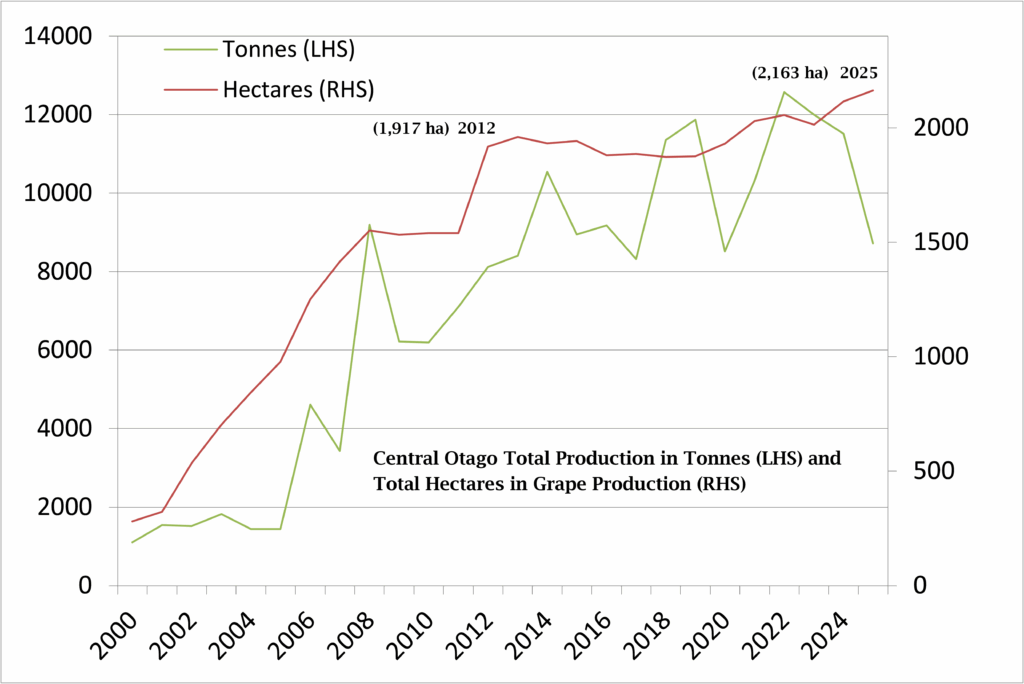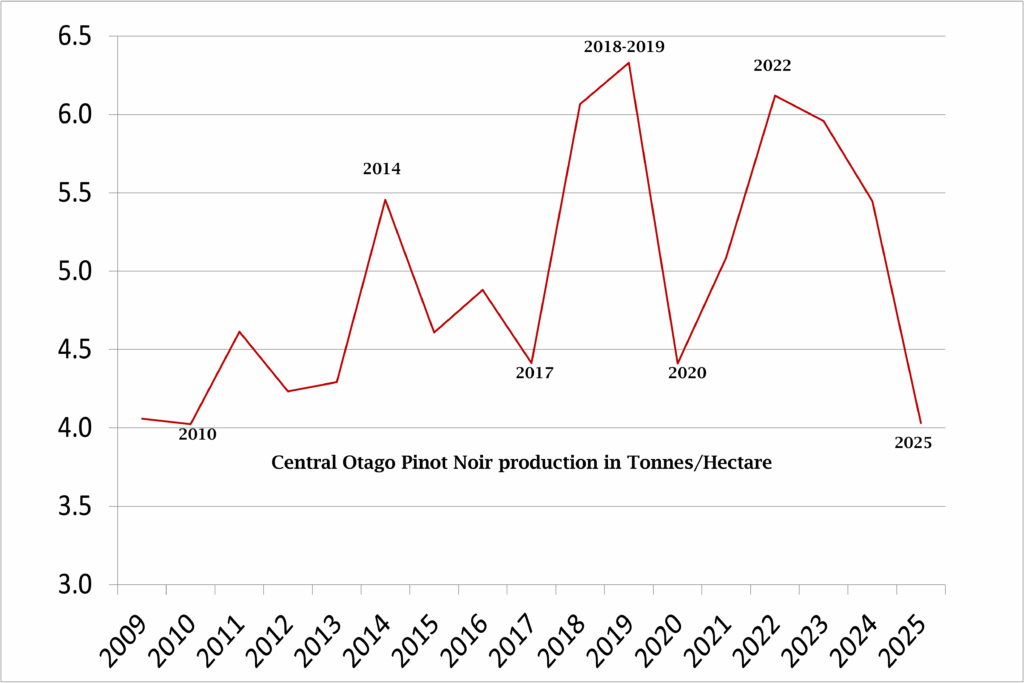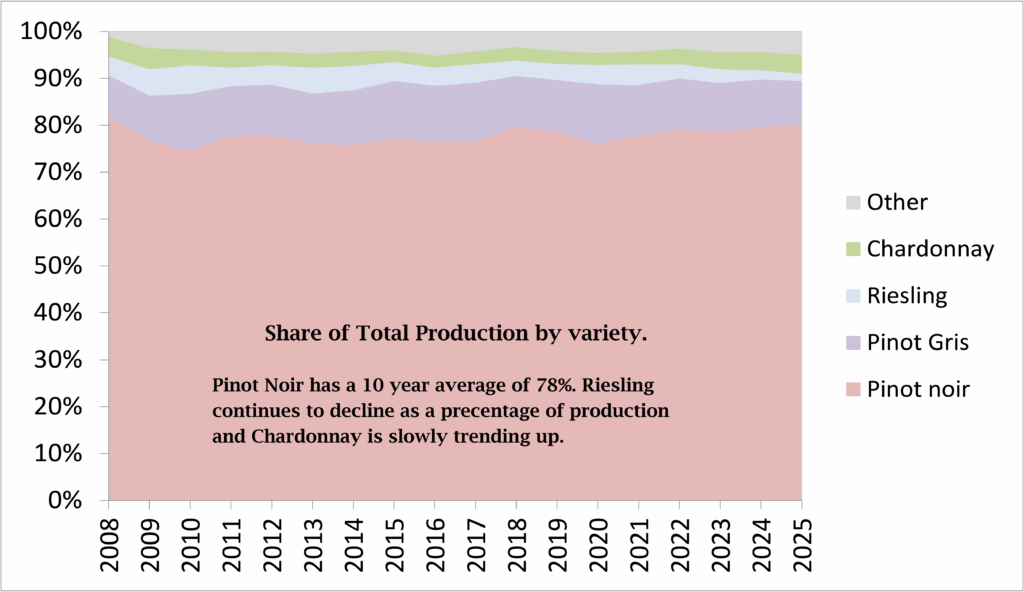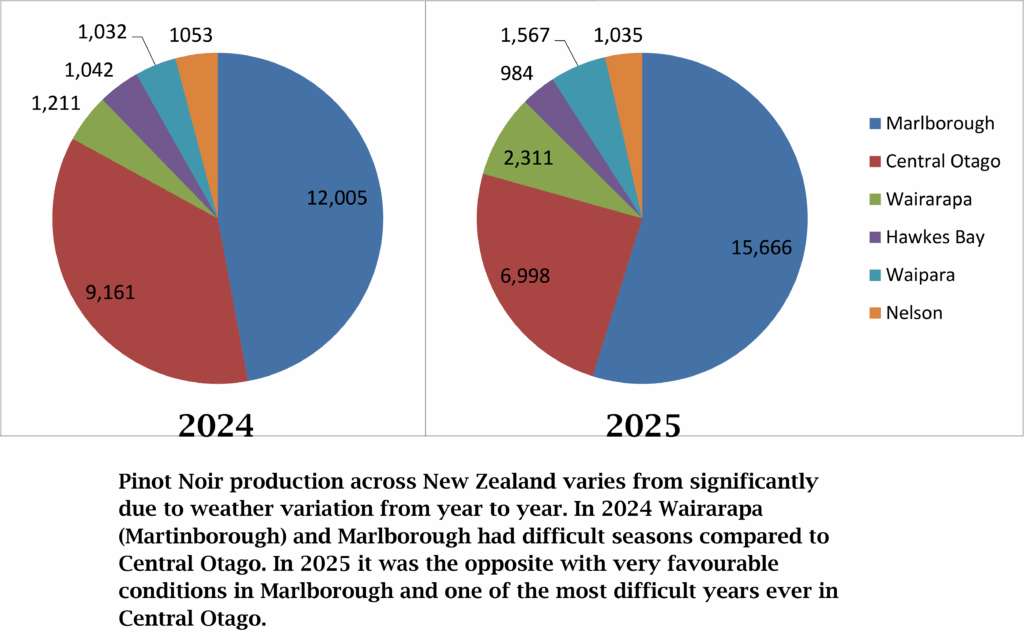It’s hard to believe how far Central Otago has come since 1991, when the region produced a modest 56 tonnes of grapes. Fast forward to the present, and the latest 2025 Vintage Survey from New Zealand Winegrowers gives us the clearest picture yet of how this year’s production has unfolded—particularly in the region’s flagship, Pinot Noir.
With a longstanding interest in Central Otago and its wines, I’ve collated and charted historical data to better understand the trajectory of the region’s growth and the seasonal nuances affecting the latest vintage. Here are some key observations from the data:
Chart 1: Total Production and Area Under Vine (2000–2025)
This chart illustrates both total grape production (in tonnes) and total planted area (in hectares). Central Otago experienced rapid vineyard expansion up to 2012, peaking at 1,917 ha. Since then, growth has plateaued, with the area under vine in 2025 sitting at 2,163 ha—just a modest increase over 13 years. During the expansion phase, production lagged by 2–3 years, reflecting the natural delay until new vines reach full yield. Since 2014, with vineyard growth largely static, seasonal conditions have become the primary driver of vintage variation.
One standout year is 2008, when production reached a record 9,195 tonnes. That exceeds the most recent, and notably difficult, 2025 vintage, which came in at 8,717 tonnes.

Chart 2: Yield per Hectare
This metric (tonnes per hectare) shows 2025 as the lowest-yielding vintage since 2010. While this is less than ideal from a volume perspective, it is not a reflection of wine quality—which is still expected to be high. Lower yields often correlate with greater concentration and complexity in the final wines. Vintages with lower production—such as 2025, 2020, 2017, and 2010—share a common factor: cool and wet spring conditions, which disrupt flowering in December. This timing is critical to fruit set, and adverse weather during this window has a direct impact on yields.

Chart 3: Variety Breakdown
Pinot Noir continues to dominate Central Otago, accounting for approximately 78% of total production. Pinot Gris remains the second most planted variety. Over the past decade, Riesling has declined in volume, while Chardonnay has seen a slight increase—though total volumes remain small. The varietal mix remains stable, with Pinot Noir firmly entrenched as the region’s signature grape.

Chart 4: Regional Pinot Noir Production: A Tale of Two Vintages
Chart 4 compares regional shares of Pinot Noir production (T) across New Zealand for 2024 and 2025, clearly illustrating the vintage variation between the two years. In 2024, Wairarapa (Martinborough) and Marlborough faced challenging growing conditions, while Central Otago enjoyed a more favourable season. In contrast, 2025 reversed the trend: Marlborough experienced a strong vintage with ideal conditions, while Central Otago endured one of its most difficult seasons on record.

Reflections on the 2025 Vintage
Despite a difficult growing season, there’s every reason to expect that the best 2025 Central Otago wines—especially Pinot Noir—will be superb. However, there will be less of it available, particularly in the $20–30 retail segment, simply because some producers did not make wine at that price level this year.
The defining challenge of the 2025 vintage was the November 2024 frost. Occurring during a critical stage of flower and early shoot development, this frost was particularly severe —characterised by freezing air that traditional wind-based frost protection systems could not combat. Damage varied widely, not just between subregions but even within individual vineyards. The New Zealand Winegrowers survey reports a 24% drop in production for Central Otago compared to 2024.
Notably, the effectiveness of frost protection infrastructure made a significant difference. For instance, Grasshopper Rock in Alexandra, equipped with sprinkler-based frost mitigation, recorded its best harvest since 2019. In contrast, some vineyards without such systems suffered losses of 50% or more. The vintage has underscored the vital role of reliable frost-fighting strategies in mitigating climatic risk.
Conclusion
The 2025 vintage in Central Otago was shaped by adversity—but also resilience. While spring frosts led to a significant decline in overall production, the depth of viticultural experience and adaptive practices across the region helped safeguard quality. For consumers, this means fewer bottles on the shelves, but what is released will likely represent the very best of Central Otago in a challenging year: wines of purity, precision, and enduring character.
Phil Handford, July 2025.
